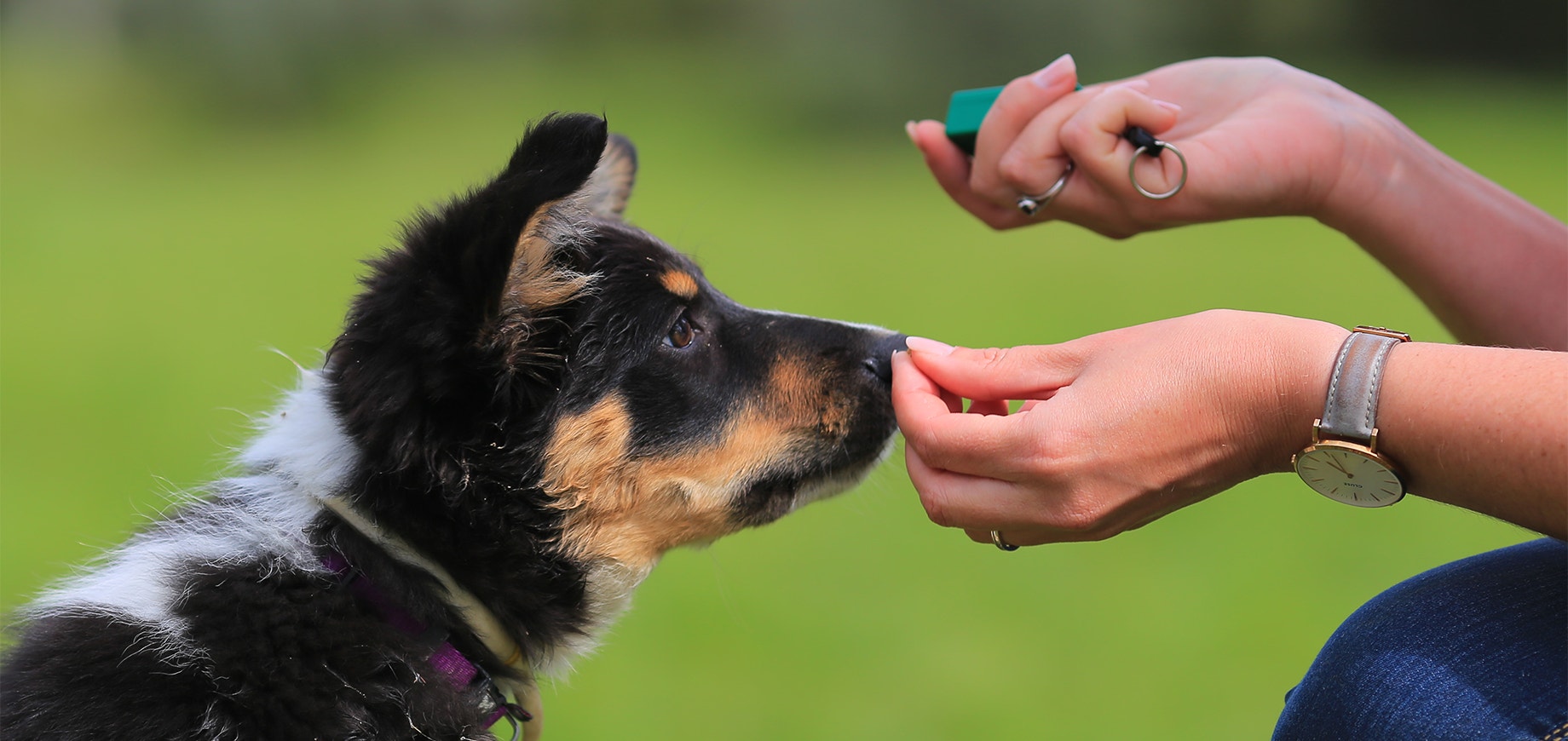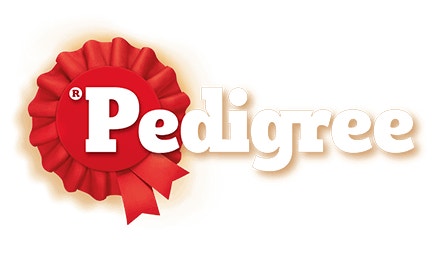

If you've heard people raving about dog clicker training and wondered if it might be worth trying with your canine companion, you’ve come to the right place. Clicker training can be used for dogs of all ages and can help with teaching basics, such as recall, and also for fun tricks (should you and your dog be in the mood to show off a little!).
Clicker training harnesses scientific principles of operant conditioning, making it faster and clearer than traditional treat-only methods. So, whether you’re interested in dog training for an older dog, or want to train your new puppy, our handy guide will walk you through how to use a clicker for dog training, as well as some common mistakes to avoid, to show you how to clicker train a dog in six easy steps.
Dog clicker training uses positive reinforcement through sound to help your dog associate certain good behaviour with a clicking noise. A clicker is more reliable than a voice, as clicking at the exact moment of correct behaviour acts almost like a photograph, letting a dog know exactly what was being rewarded. This technique works best for reward-based dog training, as the clicker becomes meaningful when paired repeatedly with a reward or treat.
A clicker for dog training is a small plastic box that makes, you guessed it, a clicking sound when pressed. This enables clear, rapid communication between dogs and their trainers. If you’d like to know how to clicker train a dog yourself, read on.
From introducing the new system to the moment your dog repeats the action on their own, clicker training can be mastered at home using these simple steps. Before you start, you’ll need:
Successful clicker training relies on rewards so before you start, it’s important to choose which treats you’re going to use. Because you’re likely to get through a fair few, you’ll want to use something small and high-quality. PEDIGREE® TASTY MINIS will fit the bill perfectly. Some dogs’ motivation differs from others, as well as their dietary requirements, so it’s also possible to use their favourite toy or lavish them with lots of affection and praise instead.
A clicker for dog training is simple to use, but before you get the clicker anywhere near your dog, it’s a great idea to get used to it yourself. Practise clicking at the exact second you mean to, maybe by having a TV programme on and clicking every time the actors say a certain word. A top expert tip is that timing is everything, so by practicing yourself before you start training, you’ll help to set yourself - and your dog - on the path to success.
Once you’re comfortable with the clicker, it’s time to show it to your furry friend. Try to avoid pointing it at them or holding it like a remote, which could be off-putting to your dog. Keeping it behind your back, in your pocket, or at your side is better. With a treat in one hand and the clicker in the other, click the clicker once and immediately give your dog the treat. Repeat this a few times, and your dog will soon learn to associate the click with a reward. Dogs are intelligent and most learn quickly, so be sure to keep it consistent with the click/immediate reward system.
The next step is to incorporate the clicker into training. This means simply giving your dog a click followed by a reward when they perform the behaviour you’re asking them to. Choose a good time for your dog, when they’re not too tired or too hungry, and find a quiet space with no distractions to ensure their full attention. As soon as they do the action you want, click once and quickly reward them. Try to keep the training sessions short and enjoyable for them, and stop when your dog starts to lose interest.
The key to clicker training success is consistency and accuracy. Make sure you only click once, at the correct behaviour, to make sure your dog understands the association, and reward all (even accidental) clicks. Professional dog trainers advise against using the clicker to get the dogs’ attention, and instead keep it only for a distinct purpose to reward specific good behaviour. Never punish your dog for not doing as you ask. By staying consistent in your approach and making sure your dog enjoys the sessions, you’ll start to see results in time.
Once your dog reliably performs the behaviour you’re wanting, you can start to replace the click with verbal praise and only intermittent treats. You can replace the click with a verbal command, and start to prioritise affection and play as a reward. Some dogs do still need a little food treat every now and then to stay motivated, but others may no longer need this to reinforce good behaviour. Remember to keep training sessions short, up to 15 minutes at the very most, or you could try shorter sessions several times in a day.
The secret to how to clicker train a dog successfully comes down to consistency as well as timing. It’s important to click the clicker at exactly the right moment when your dog does what you want them to do, as even half a second too early or late could reinforce the wrong action when you’re communicating with your dog. Think of it almost as if you are trying to take a photo of the behaviour you’re encouraging. Maybe you’re trying to teach your furry friend to sit, for example, in which case you need to click as soon as their bum hits the floor, and then give them a reward within a few seconds. Don’t worry if this sounds challenging – the more you practise, the quicker you’ll get with your clicks.
In this section, we’ll highlight some of the most common errors owners make during clicker training. It’s easy to make mistakes when you first start, especially if you’re a new dog owner, but here we’ll offer some solutions to common problems as well as how to avoid potential issues.
A small delay of just a second or two can confuse your dog, as they won’t know which action is being rewarded. If this happens, try again when your dog is ready, and consistently click once and reward until they understand. Practicing with your clicker before the training starts can help you get used to the timing.
Dogs are smart, and they’ll know something is off if they don’t get their expected reward. In the early days, a lack of treat reinforcement can make them much less likely to co-operate. Make sure you always reward them after every click, and they’ll soon associate the clicking sound with something good coming their way. If you run out of treats, stop the session and pick it up another time.
Your end goal is to get your dog to perform the expected action using a voice command, rather than a clicker, so training has to be part of a longer-term plan. After all, you don’t want to be carrying a clicker with you wherever you go. As soon as your dog has mastered the clicker command and reward, start adding verbal cues too, so that your dog understands. Once they do this reliably, try phasing out the clicker and using only the command and reward.
Too slow or intermittent treat delivery can confuse your dog, as they won’t know to associate the sound with a reward. It’s best to keep treats hidden yet easy for you (not your dog) to access, and always reward even for accidental clicks. Inconsistency can slow progress significantly, especially in the early days, so choose small treats that you can grab fast.
Over use of the clicker can confuse your pet as they won’t know which action is being encouraged, and it can even distress some dogs. Dogs have significantly better hearing than humans, so too many clicks can have a negative effect on their mood. Click only once, and if it’s too noisy for them, try keeping it in your pocket to dampen the sound.
Some dogs prefer toys and affection over food treats, so if your training is stalling, you could try switching up rewards. Remember, too, that any treats you do give your dog should be taken into account as part of their daily intake, to avoid the risk of putting on excess weight. Ideally, using play or games as a reward will help to keep your dog active and will help to build your bond.
You can clicker train a dog of any age, whether they’re a young pup or a senior citizen. The only difference? A puppy might pick up the new skills more quickly. We all tend to learn a bit faster when we’re young, but you can still teach an old dog new tricks! In fact, if you have a shy pup, clicker training can be great for reactive or fearful dogs as the click is non-threatening and non-coercive. It can support nervous or noise-sensitive dogs by pairing the click with a reward, and by training together, you can reinforce your unique bond.
Clicker training is a powerful, science-backed dog training tool that enhances communication and accelerates learning. It’s a positive step in your relationship, suitable for dogs of all ages, and can - and should be - fun. Try starting small, practising your timing and gauging your dog’s response, and by avoiding common mistakes, you’ll start to achieve new successes together. Once your dog has mastered the basics, you could even move on to more exciting tricks! So, from how to teach a dog to sit, to toilet training, discover more about dog training on our PEDIGREE® blog.
Inconsistent use of the clicker can lead to confusion, which can stall your dog training, so it’s useful to practice using the clicker beforehand. However, with the right technique and by making it a fun experience for your dog, many dog owners have enjoyed rapid success.
No! Dog training experts say that it’s never too late to start clicker training, and even older dogs can respond well to the technique. Although younger dogs and puppies may learn faster, older dogs can enjoy learning new skills using a consistent approach and reward system.
Yes. Although most dog trainers advocate using the clicker only for good behaviour and training, it is possible to reward your dog using the clicker when they behave well after doing something wrong to encourage positive actions. For example, when they start to sit after jumping up at people.

